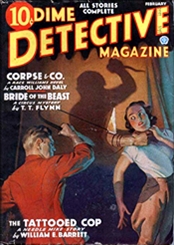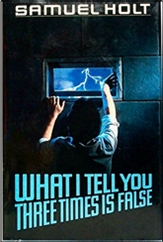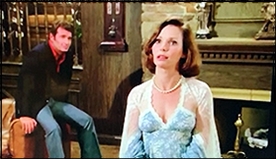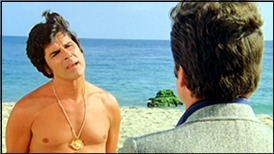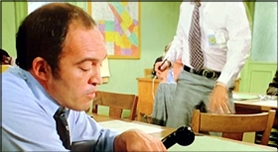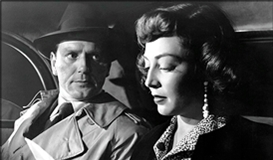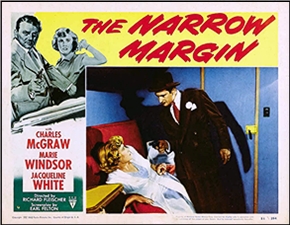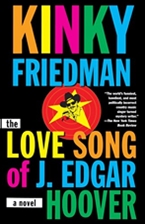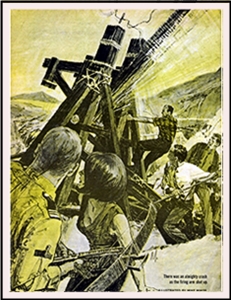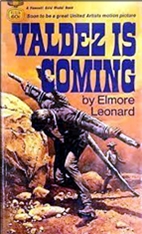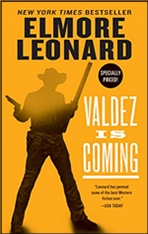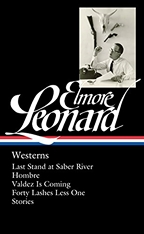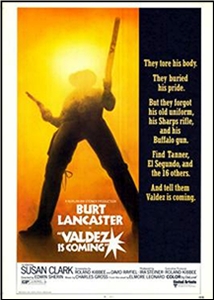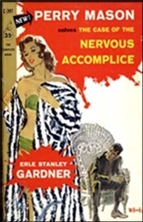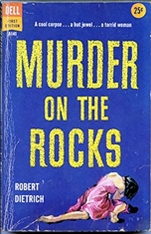REVIEWED BY DAVID VINEYARD:
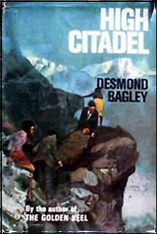
DESMOND BAGLEY – High Citadel. Collins, UK, hardcover, 1965. Doubleday, US, hardcover, 1965. Pocket, US, paperback, 1966. Pyramid, US, paperback, 1972. Harper, paperback, 2009, in a 2-for-1 edition with Landslide. A condensed version appeared as a “book bonus” in the August 1965 issue of Argosy Magazine (see the illustration taken from that issue at the end of this review).
Tim O’Hara is a down on his luck ex alcoholic pilot working for a fledgling airline flying in the Andes.
A Dakota was being loaded and, even at that distance, the lights were bright enough for O’Hara to see the emblem on the tail – two intertwined ‘A’s, painted artistically to look like mountain peaks. He smiled gently to himself. It was appropriate that he should fly a plane decorated with the Double-A; alcoholics of the world unite – it was a pity Filson didn’t see the joke. But Filson was very proud of his Andes Airlift and never joked about it. A humourless man, altogether.
O’Hara’s job is to ferry a disparate group of passengers over the Andes to their destination, and he has no idea how challenging that is going to prove to be.
Grivas (the radioman) said softly, ‘Señor O’Hara.’
‘Don’t bother me now.’
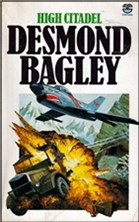
‘But I must,’ said Grivas, and there was a tiny metallic click.
O’Hara glanced at him out of the corner of his eye and stiffened as he saw that Grivas was pointing a gun at him – a compact automatic pistol. He jerked his head, his eyes widening in disbelief. ‘Have you gone crazy?’
Grivas’s smiled widened. ‘Does it matter?’ he said indifferently.
Hijacked, they crack up on a mountain landing strip too small for the Dakota, and O’Hara and his ten passengers find themselves in an even worse situation than surviving a plane wreck. Cordillera, the small country on the South American continent where they have gone down is currently held by a Communist dictator and one of the passengers is his chief opponent.
Naming any single book by a writer like Desmond Bagley his best is tricky business, especially when the competition includes The Vivero Letter, Running Blind, Freedom Trap (filmed by John Huston as The MacKintosh Man), The Spoilers, Bahama Crisis and some of the best reviewed thrillers of the latter half of the 20th Century.
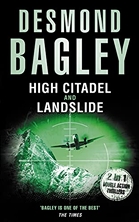
Bagley was a South African actor (Basil Rathbone was a cousin, also a cousin of Daphne DuMaurier) turned writer who turned an eye for the telling detail, a knowledge of character as well as plot construction likely from his acting experience, and a natural talent for twisty plots that took dangerous turns for reader and protagonists into a series of top selling novels. As an adventure writer, he rivaled Alistair MacLean at his best for sheer pace and action while his mystery plots would not be lost in an Agatha Christie book. He was soon rivaling Hammond Innes and MacLean in sales and surpassing such masters as Victor Canning, Gavin Lyall, and Geoffrey Household in name recognition.
Virtually overnight he went from obscurity to one of the best known practitioners in the field of the classic British adventure thriller.
Unlike those masters, Bagley never wrote the same book twice. Each Bagley novel is unique in voice, subject, and style as at home with the first person narrator favored by the John Buchan school as the third.
Above all, his books are entertaining page turners, never teased by success into over extending themselves or pretension. Bagley recognized his strengths as a writer early and honed them while still remaining fresh and maintaining the ability to surprise his readers.
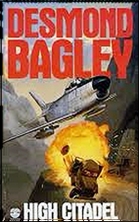
High Citadel is an early book, but one that shows a skilled hand. It is a shade more novelistic than some of his work, more in line with Nevil Shute, Ernest K. Gann, or David Beatty than the standard thriller, but it never forgets it is primarily and adventure story written to entertain and provide escape from the workaday world which it does with thrills, chills, and not a little wit.
At heart it is a Grand Hotel plot. A disparate group of people who share nothing but the coincidence of being passengers on a flight that goes down in the middle of a South American revolution and have to make their way out of rebel territory to safety must battling human nature, their own foibles and flaws, nature, those who want to take them hostage or murder them, and finding in themselves the ingenuity and strength to survive.
It’s a pity it was never filmed because you can easily imagine the cast, including an old maiden New England school teacher who is a deadly accurate archer born to be played on screen by an Edna May Oliver type and an aging medievalist who happens to know how to make a crossbow.
I read this sometime in the Seventies and there are passages as vivid today in my mind as when I read them for the cinematic wide screen quality of some of the set pieces and the human well drawn characters.
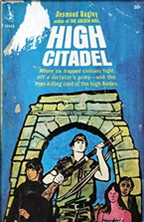
The hero, battling his own demons, must overcome them and hold together his small army of strangers, uncertain who can be trusted and well aware they are surrounded by ruthless Cuban-trained soldiers willing to murder them all to get to the one man among them they are hunting.
Inevitably their luck runs out and the high citadel they have created faces an onslaught of superior force.
‘I’m sorry to be pessimistic,’ he said. ‘But I think this is the last act. We’ve done very well considering what we had to fight with, but it couldn’t go on for ever. Napoleon was right – God is on the side of the big battalions.’
Her voice was savage. ‘We can still take some of them with us.’ She grasped his arm. ‘Look, they’re coming.’
Signaling a battle royal that runs right up to the wire with action, suspense, and the heart that too few modern adventure writers manage to instill for all their pyrotechnics.
High Citadel is a fine read, a top notch thriller, but something more with human characters you care about and all from the hand of a sure master who hit the ground running from his first printed word and never looked back. For thrills and consistent brilliance it is hard to top Bagley.
This is thriller writing at its best.
